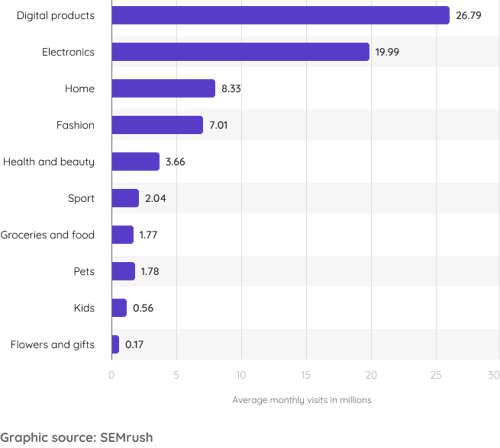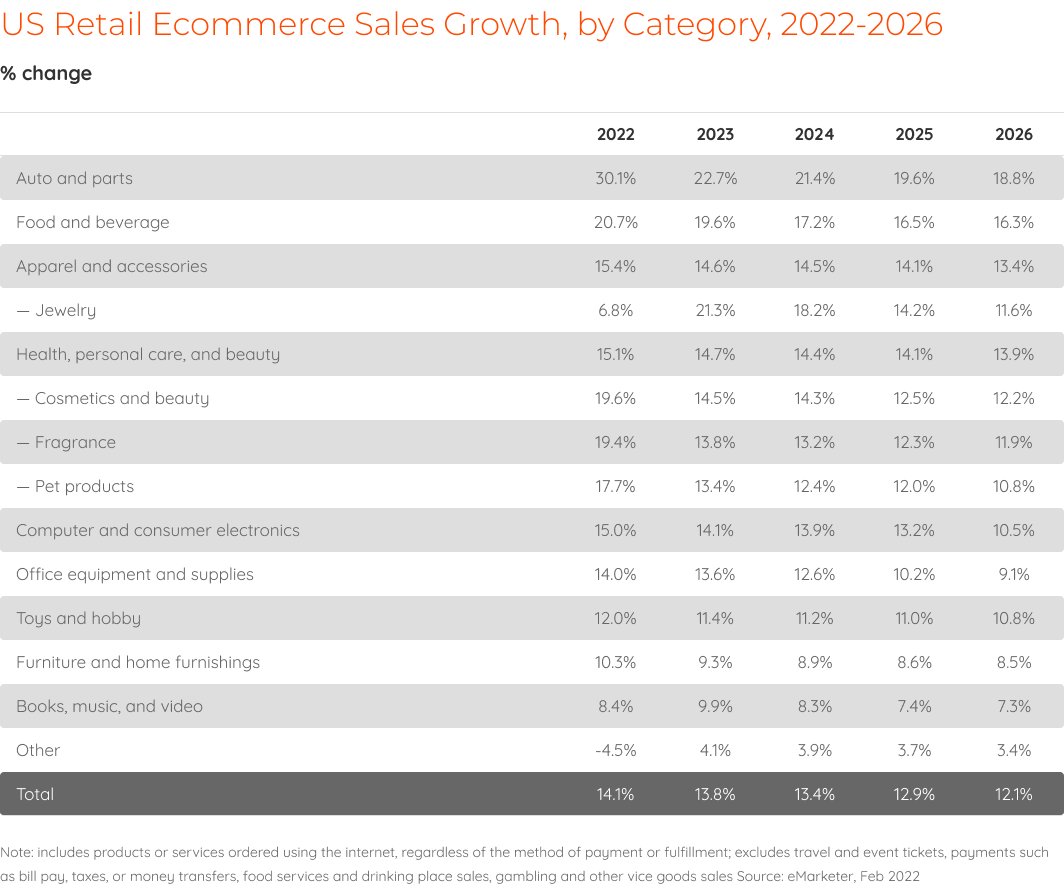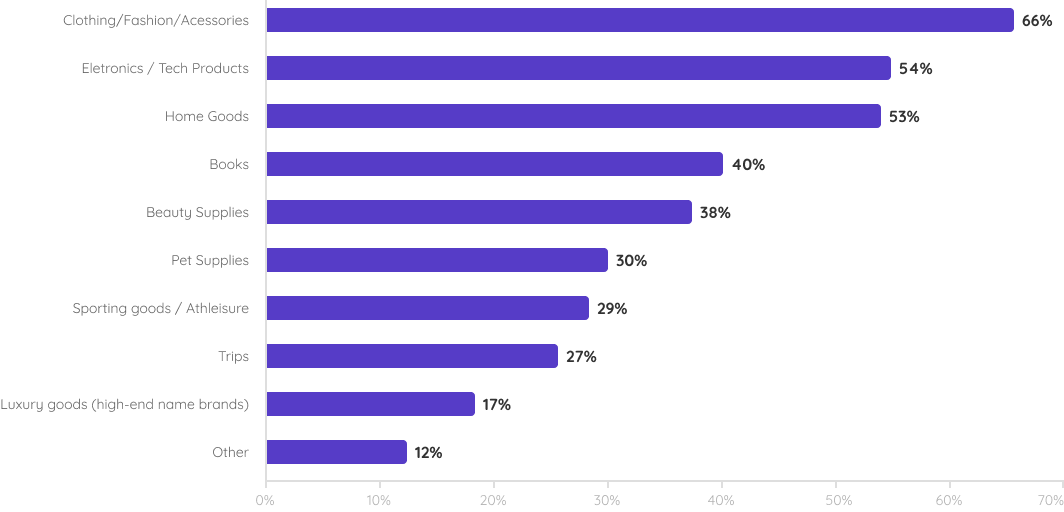-
Introduction
Ecommerce Industry Guide: Consumer Electronics
-
Chapter 1
Industry Overview
-
Chapter 2
Consumer Electronics & Ecommerce
-
Chapter 3
Fraud Risk in the Consumer Electronics Industry
-
Chapter 4
How the Consumer Electronics Industry Can Combat Ecommerce Fraud
-
Chapter 5
How ClearSale Helps Consumer Electronics Companies
-
Chapter 6
ClearSale Helps Motorola Wipe Out Chargebacks and False Declines
The State of the Consumer Electronics Market
Consumer Electronics
& Ecommerce

Consumer electronics products have been popular choices for online shoppers since the very beginning of ecommerce.
Globally, consumer electronics continue to be a category that commands a large market share of all ecommerce sales. Pre-pandemic, consumer electronics was the ninth best-selling product category online. While updated global figures aren’t yet available, U.S. consumption clearly shows that that ranking has likely increased.
In the United States, consumer electronics websites (digital products and electronics) occupied the top two spots for average monthly website visits in 2021.

Graphic Source: SEMrush


Graphic source: insiderintelligence.com
Consumer electronics currently represent about 15% of all online sales, and, despite projected growth in other categories, it’s on track to remain in the top five ecommerce retail categories in the United States.
And our own data has shown that consumer electronics is the second most-purchased ecommerce category in several global markets.
Of the categories bellow, which are you most likely to purchase from online retailers?

Graphic Source: ClearSale's Original Research Report | State of Consumer Attitudes on Ecommerce, Fraud & CX 2021
So, who’s reaping the benefits of this rush online?
The field is definitely starting to expand.
Leading Consumer Electronics Ecommerce Brands
Consumer electronics businesses face heavy competition online from some of the most successful companies on the planet.
In the United States, ecommerce sales of consumer electronics are led by Amazon.com, with $21.2 billion in revenue, followed by:
- Apple.com, $20 billion
- Walmart.com, $20 billion
- Bestbuy.com, $15 billion
- Dell.com, $2.5 billion
At the same time, companies such as Back Market, the Swap Club, and Framework are getting attention from publications like Fast Company for reducing consumer electronics e-waste by selling refurbished and upgraded electronics as well as making repairs.
This market continues to expand as technology and development push the boundaries of what’s possible.

CX and Consumer Electronics Ecommerce
We talked at the beginning of this guide about friction and how important it is to reduce friction for customers. Friction is a key measure with CX. The amount of friction customers have to endure is directly related to what they think of a brand.
Here are some ways to help your business reduce friction and increase online sales:

1. Optimize your website
A smoothly functioning website doesn’t just make the buying experience more pleasant for consumers (although it does do that). It also speaks to the quality of your products.
Tech buyers expect well-built products that are user-friendly and frustration-free. Your website should be the same. That means it should load quickly and be easily navigable on any screen. Keep in mind that today’s most successful online retailers have a “mobile-first” approach.
Another aspect of optimization is how easy products are to find.
2. Simplify your checkout process
A long, drawn-out and confusing checkout procedure is one of the main reasons the average ecommerce site loses 75% of the value of potential sales to cart abandonment. A speedier checkout process can recapture much of this revenue.
A customer-friendly checkout process includes:
- Single-page checkout (as opposed to multiple steps).
- Mobile optimization.
- Multiple payment options, such as Apple Pay and PayPal, in addition to the common credit card brands.
- The option to check out as a guest (rather than creating an account).
- The total order cost upfront, including shipping and taxes.
- A minimal number of data fields.
3. Customize search and filter functions
As we mentioned in the first chapter, many of your customers are just getting used to online shopping. They aren’t accustomed to having to search for products, and can get flustered quickly when they’re used to just asking someone in the store. Navigation, search and filtering functionality need to be intuitive and easy to use.
At the same time, your experienced customers should be able to use the virtual “express lane” if they know what they want and where to find it.
It’s a challenge.
Consider sidebar menus that are fixed and make it easy to navigate between product types, colors, sizes, prices, etc., without having to backtrack. Offer similar filters that make it simple to adjust characteristics as needed.
That will give naïve customers an idea of where they are on your website, and it allows experienced customers to skip directly to what they want.
4. Add personalization
It’s absolutely critical to know your customers and what they want from their online experience. Think about it — different customers will interact in different ways with your online presence.
“Every ecommerce business needs to put themselves in the shoes of their customers — all their customers. Different customers want different things, but they all want a great customer experience. Every part of your business, including your fraud protection, needs to align with delivering personalized and excellent CX.”

— Rafael Lourenco
ClearSale Executive Vice President & Partner
In an industry that has had a strong brick-and-mortar presence for decades, the pressure to deliver superior and personalized CX should be a top priority. One trick to make that happen is adding a chatbot. Think of it as your website’s online concierge.
Make use of chatbots
Ecommerce chatbots are helpful because they satisfy one of the most basic shopping needs: information. About 90% of customers want answers to their question(s) within 10 minutes, to be exact. A chatbot can do that. Program logic and data allow chatbots to answer common queries, ask helpful questions and suggest products, making it easier for consumers to find exactly what they’re looking for that much faster. And chatbots can be programmed to appear wherever the customer is along their buyer’s journey.
5. Take advantage of video marketing
Video has become one of the most effective and widely used marketing tactics for online consumers. It can increase conversion rates by up to 80%, and 66% of people say they prefer a short product video over reading text about a product.
A well-shot video is often better than in-store handling of products, because it can demonstrate the correct way to use and care for those products.
That’s great news, right?
Yes, as long as your videos are professionally shot, strategically placed and engaging. With so many other retailers using video, the key to rising above the noise will be how compelling yours is.
6. Step up your omnichannel presence
If you’re selling to younger generations (And who in consumer electronic isn’t?), you’ll need to factor in how m-commerce, social commerce and other channels are used by those consumers. They’re on their phones — almost constantly. Why not meet them where they’re at with apps and social media shopping?
Here are some ways to take advantage of multiple ecommerce channels:
Social commerce through Instagram Shopping, Pinterest Lens, TikTok and other social media has made it possible for highly targeted marketing and sales campaigns based on social and online habits. The algorithm is real, giving retailers the opportunity to put the products shoppers want right in front of them.
Progressive web apps (PWAs) are app versions of your website that allow for push notifications and access to a camera, a microphone, GPS, voice commands and other app-like features. They also run faster, which adds to CX.
Smart speakers and voice assistants facilitate voice commerce, which is predicted to be an $80 billion revenue generator by 2023. In a post-pandemic era, where consumers have become much more aware of infection prevention, touchless consumerism is here to stay and 86% of consumers favor voice technology.
Virtual reality (VR) and augmented reality (AR) are mainstream technologies where consumers can shop “in-store” like they would in a brick-and-mortar experience. For younger customers, the “coolness” factor is turned up to 11.
7. Avoid needlessly aggressive fraud filters
Fraud prevention is critical — especially in the consumer electronics industry. But if your anti-fraud filters are too restrictive or burdensome, they may cause you to lose legitimate customers.
For example, velocity filters (which prevent customers from making multiple orders within short periods) can shut down impulse buys. This means if someone buys a video game console and then decides on the spur of the moment to splurge on an expensive controller, your fraud filter might stop them. Later in this guide, we’ll discuss some alternatives to rigid rules-based filters.

